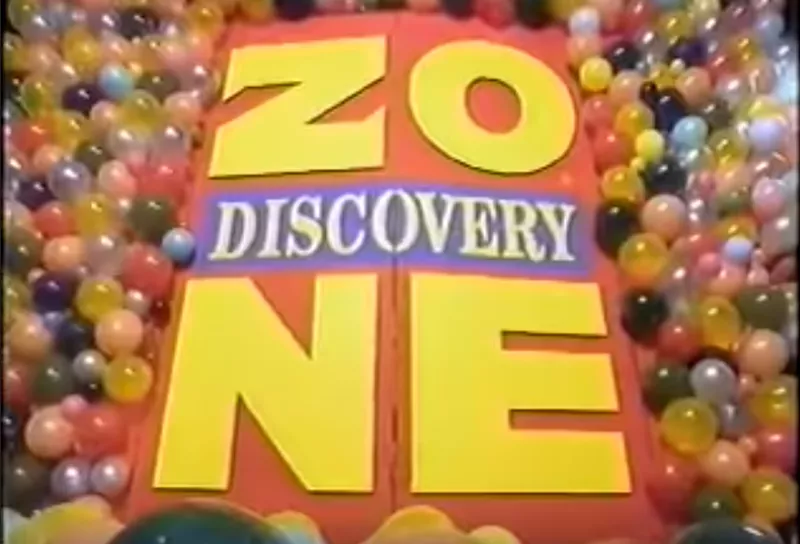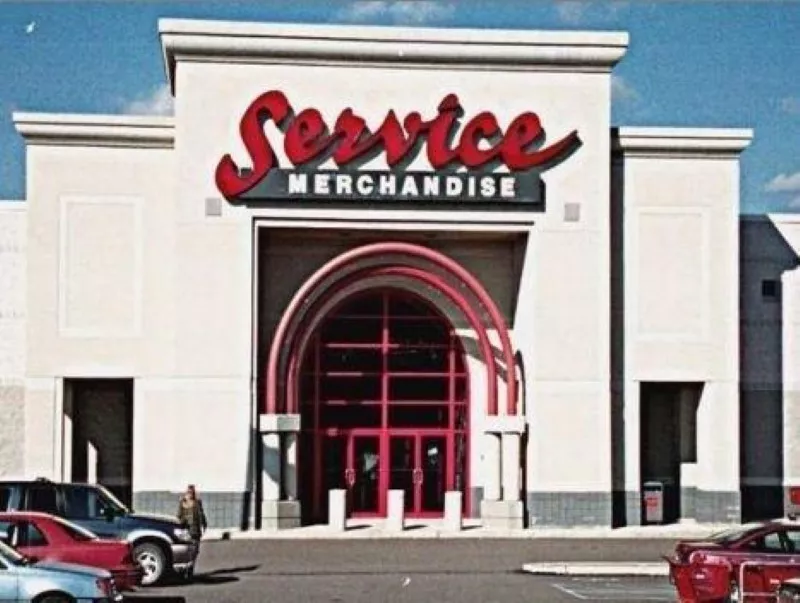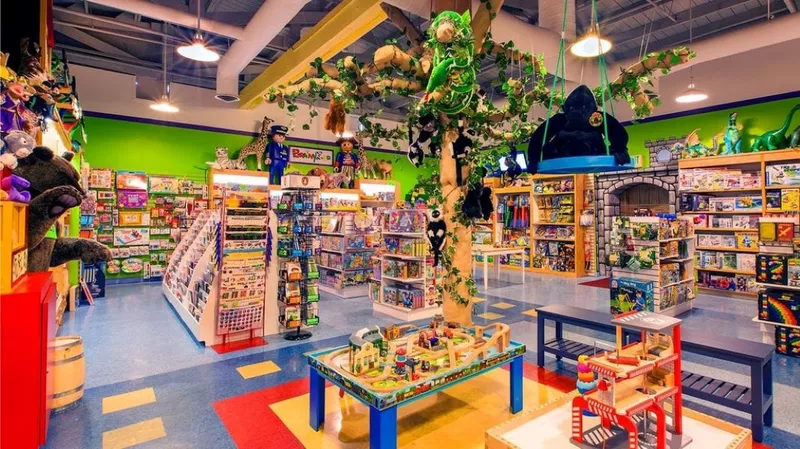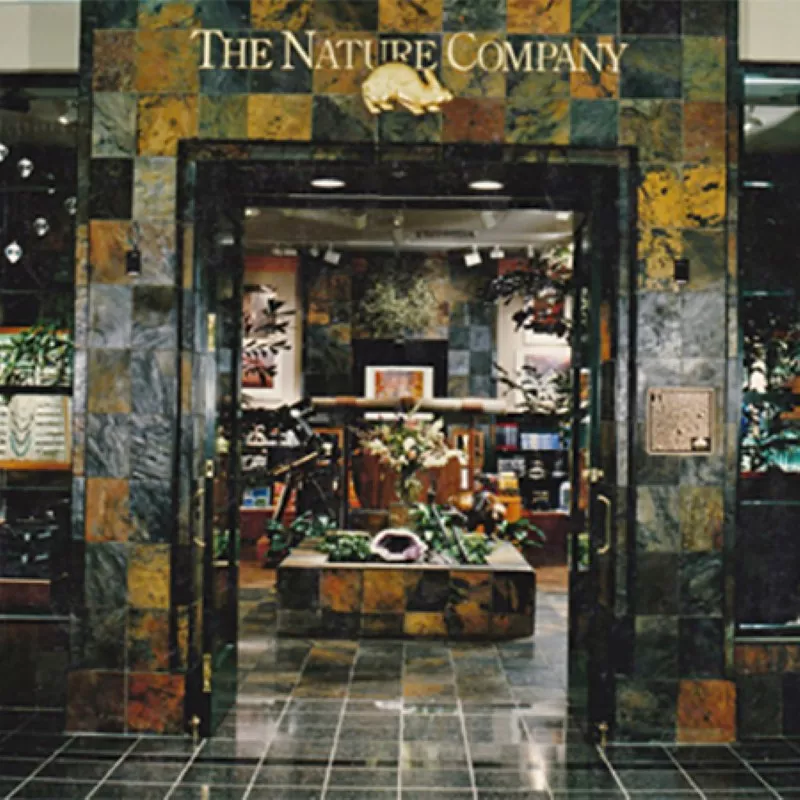After retail stores like Forever 21 and Payless ShoeSource filed for bankruptcy a few years ago, it reminded us of all the fantastic (and not-so-fantastic) retail outlets and companies that used to dot the national landscape throughout the years.
From defunct department stores and bankrupted toy companies to fizzled-out electronic retailers, these 25 companies are the ones people miss the most — and how they’re reminiscing about them on the internet.
Blockbuster
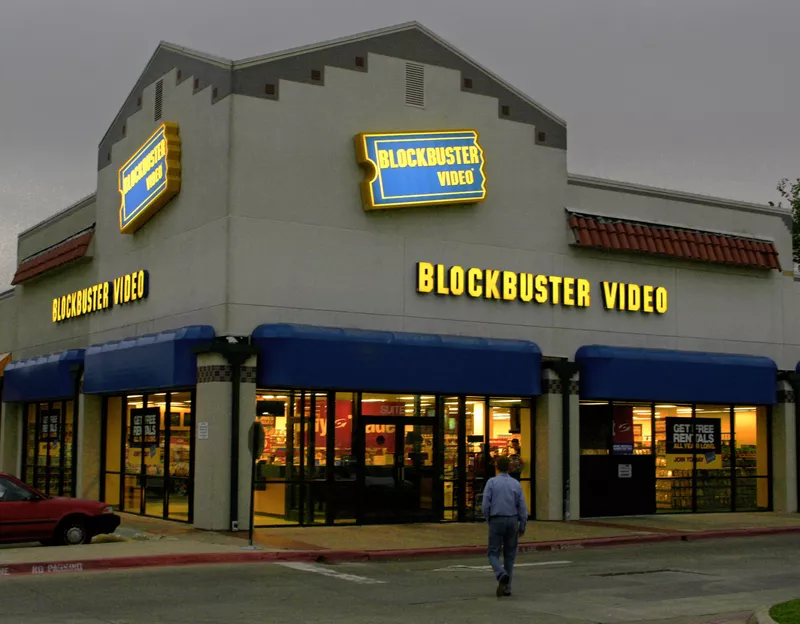
A Blockbuster Video rental store in Richardson, Texas in 2006. Ron Heflin / AP Photo
Those blue-and-yellow stores with wall-to-wall VHS tapes, DVDs and video games along with rows of checkout line candy and popcorn boomed in the 1990s and peaked in 2004 with around 9,000 outlets worldwide. But Blockbuster was not a forward-thinking company. It infamously botched a deal to acquire Netflix for $50 million and ignored the early threats of Redbox and other kiosk rental services, which surpassed video store sales by 2011.
Blockbuster was sold to Dish Network. By 2013, all but one single Blockbuster store in the world was shuttered. That remaining store is located in Bend, Oregon.
A Person on the Internet Says...
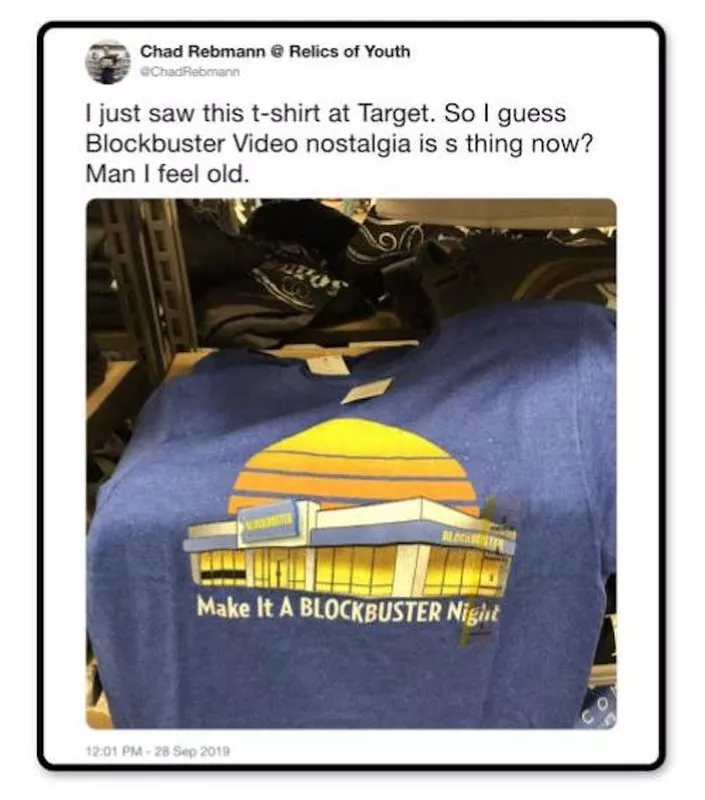
ChadRebmann / Twitter
The Wiz

Ed Bailey / AP Photo
Anyone who watched a Yankees, Mets, Knicks, Rangers or Devils game during the 1990s knows the slogan: “Nobody Beats the Wiz.” The New England-based electronic company’s slogan and its advertisements were everywhere in the 1990s, and it even inspired a “Seinfeld” subplot about one of Elaine’s obnoxious boyfriends. The Wiz was an electronics store based in New York City, founded in 1977. It went defunct in 2003, although store closings started in the mid-1990s.
A Person on the Internet Says...

JoeConteComic / Twitter
Borders

Interior of a Borders store in San Francisco. BrokenSphere / Wikipedia
Those enormous stores filled with thousands of books, DVDs and CDs started in Ann Arbor, Michigan, in 1971 as an 800-square-foot used bookstore. By 1992, it had 21 bookstores and attracted the attention of Kmart, which bought the company when it was valued at around $190 million (about $347 million in 2019 dollars).
The company was successful; in 2005 it posted an annual profit of $101 million, but just three years later lost $157.4 million. During its financial troubles, Barnes & Noble passed on buying the company and Borders took a venture capital loan of $42.5 million. As the years progressed, more and more stores closed, and profits dwindled until the entire company’s books shut for good in 2011.
A Person on the Internet Says...

michaelvogel1 / Twitter
Woolworth's
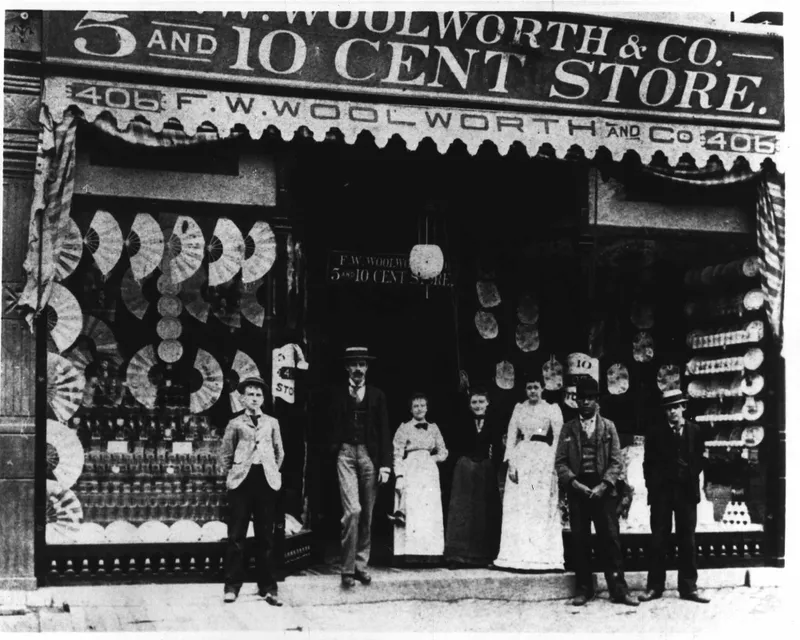
Employees at a Woolworth's store at an unknown location pose in this photo from the early 1900's. Associated Press / AP Photo
The F.W. Woolworth Company was one of the first five-and-dime stores, with its first iteration opening in Utica, New York, in 1879. Woolworth’s bloomed for a century. In fact, the Woolworth Building, the company’s headquarters, was the tallest building in New York City from 1913 until the Empire State Building was erected in 1930.
Woolworth’s decline started in the 1980s. In 1982 it had over 8,000 stores around the world, but sales declined due to the presence of big department stores like Target, Walmart and Kmart. It attempted to diversify and turn into a series of different specialty mall stores, but ultimately that failed. Except for one — World Foot Locker, which lives on today as Foot Locker.
The Woolworth name still lives in some countries, like Australia and South Africa, although the Woolworth’s we know went defunct in 1997 after it renamed itself to Venator Group and then later became Foot Locker, Inc.
A Person on the Internet Says...

CruisinSoozan / Twitter
J.J. Newberry

The J.J. Newberry in downtown Portland, 1988. Steve Morgan / Wikipedia
J.J. Newberry was a variety discount store that started in 1911 in Stroudsburg, Pennsylvania. The chain grew fast, and goods were cheap — a 1938 menu item with fried chicken, mashed potatoes, peas, coleslaw and a roll sold for 25 cents (like how Subway is probably in your local Walmart, variety stores used to have their own little food courts).
But sales declined after the postwar boom (and it seems like Dollar General was the only dollar-store to survive). J.J. Newberry closed all of its stores in 2000 and 2001, with the last location in Portland, Oregon, shuttering in 2001.
A Person on the Internet Says...

billlabrie / Twitter
Toys R Us
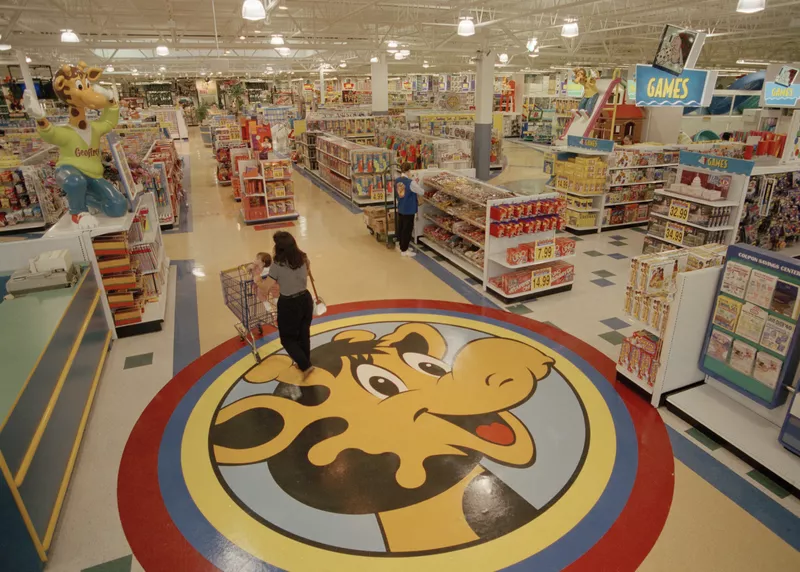
Daniel Hulshizer / AP Photo
What began as a 1948 baby furniture store morphed into an empire of brightly colored stores stuffed with children’s toys and electronics, which ultimately fell victim to $5.3 billion worth of debt that caused the company to close all of its stores in early 2018. In 2019, Toys R Us emerged again, but only as an “experiential retailer” that would “showcase products in an interactive, playground-like environment,” according to its website. Those stores — and there are only two of them — are set to open in November 2019. Geoffrey bucks will not be accepted.
A Person on the Internet Says...

slim_jemmy4 / Twitter
Circuit City
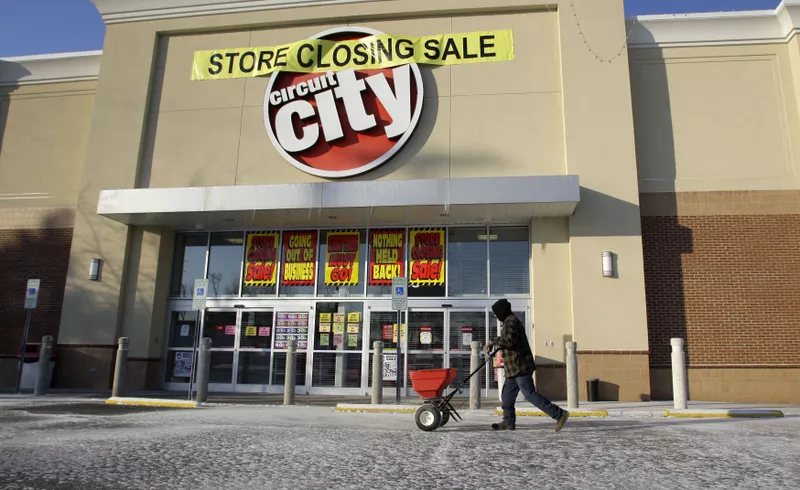
Chuck Burton / AP Photo
Circuit City started as a retail company named Wards Company in Richmond, Virginia, in 1949, but officially changed its name to Circuit City in 1984. It was a big-box retailer that sold televisions, refrigerators and other types of home electronics and appliances. But as Best Buy emerged as the new market leader in the 2000s, Circuit City’s sales declined. At its height, the company had 1,520 stores in the U.S. and Canada with 46,000 workers. The company attempted to expand, but put established new locations in inconvenient locations. Then they stopped selling appliances and were trounced by in-store promotions from its competitors. And its web presence was pitiful.
By the time it was forced to close its doors in 2009, Circuit City had acquired $625 million in debt. The company sold its name and website to TigerDirect, which now operates the company as an online-only retail store.
A Person on the Internet Says...
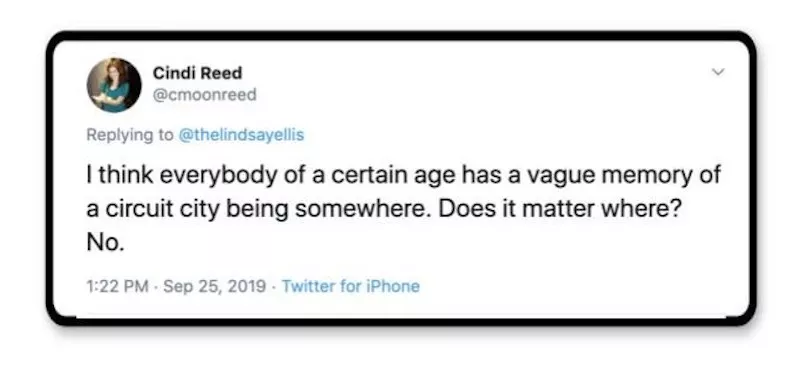
thelindsayellis / Twitter
Sharper Image
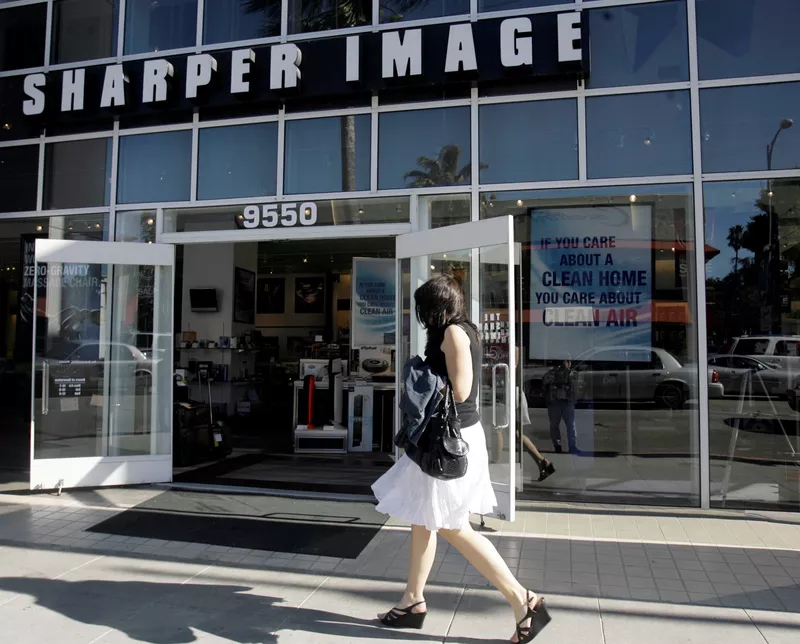
Nick Ut / AP Photo
Home to free-to-try massage chairs, flying toys, air purifiers and weird gadgets, the Sharper Image was one of those stores that was interesting to walk into and explore but nothing more. As the Washington Post wrote in its post mortem of the store for aimless shoppers, the Sharper Image sold items that “were dedicated to streamlining your life by .002 percent.”
The company went under in 2008 after it declared bankruptcy, and was then purchased by Iconix Brand Group. It later sold for a surprising $100 million to the California-based ThreeSixtyGroup in 2016. It’s now an online retailer.
A Person on the Internet Says...
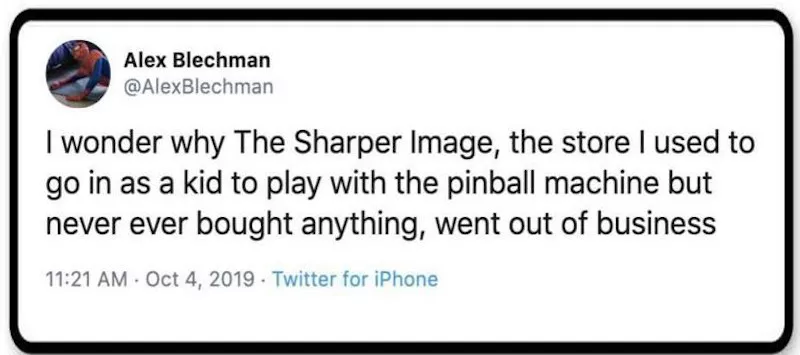
AlexBlechman / Twitter
Discovery Zone
With ball pits, yards of snaking plastic tubing, slides, rope nets and a never-ending horde of screaming children, Discovery Zone was a child’s favorite place in the 1990s. But the company only lasted nine years. Discovery Zone expanded fast and suffered under changing management and expanding debt that reached $400 million. Despite an attempted bounce back after bankruptcy in 1997, the company went bankrupt and emptied its ball pits for good in 1999.
A Person on the Internet Says...
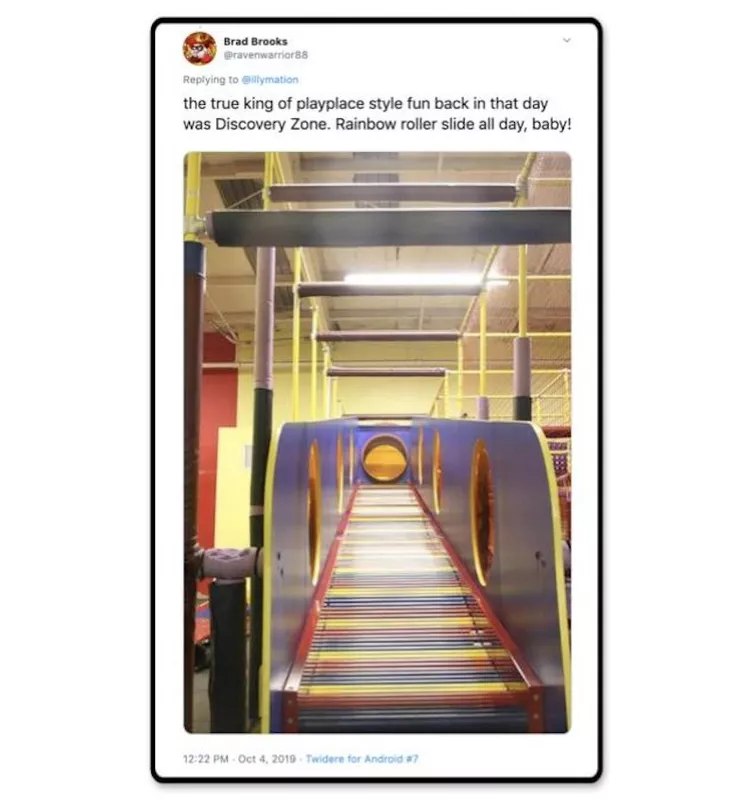
ravenwarrior88 / Twitter
Service Merchandise
Catalog retail store Service Merchandise employed a clipboard system for customers to choose products and a conveyor belt that would roll the items out (it even experimented with fast food-style item pickup drive-throughs in Chicago and Nashville). At its height, Service Merchandise had some 300 stores and net sales of $4.05 billion. But by the late 1990s, retailers like Walmart cut into its market share.
A new CEO appointed in the 1990s shifted the direction of Service Merchandise’s cheaper merchandise toward more expensive jewelry and home décor. By 1998, the company was bleeding $110.3 million. It filed for bankruptcy in 1999. By 2002, all of its stores were closed.
A Person on the Internet Says...
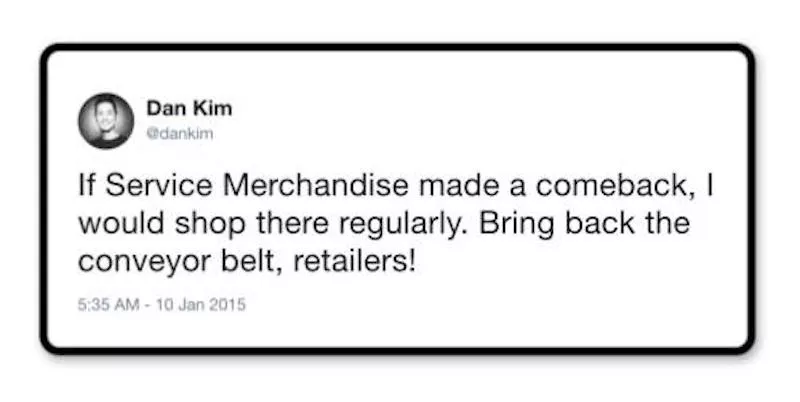
dankim / Twitter
Bradlees
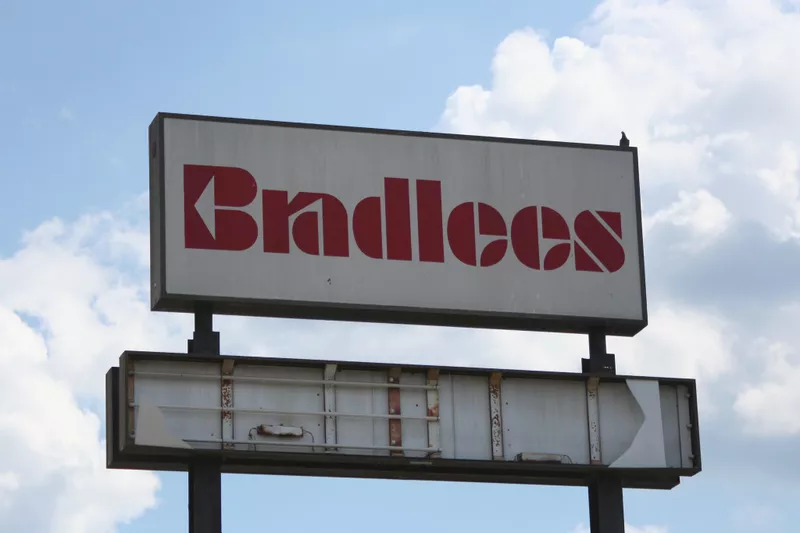
Mike Kalasnik / Flickr
Bradlees, a discount department store, originated in Connecticut. By 1958 it grew to around 136 stores before its total collapse in 2001. You might remember the company’s spokesperson, “Mrs. B,” touting the chain’s low prices on awkward television commercials, or their slogan, “The Department Store with a Difference.” The company went into bankruptcy in 1995 and attempted a recovery, but by 2001, it was dead.
A (Somewhat Famous) Person on the Internet Says...
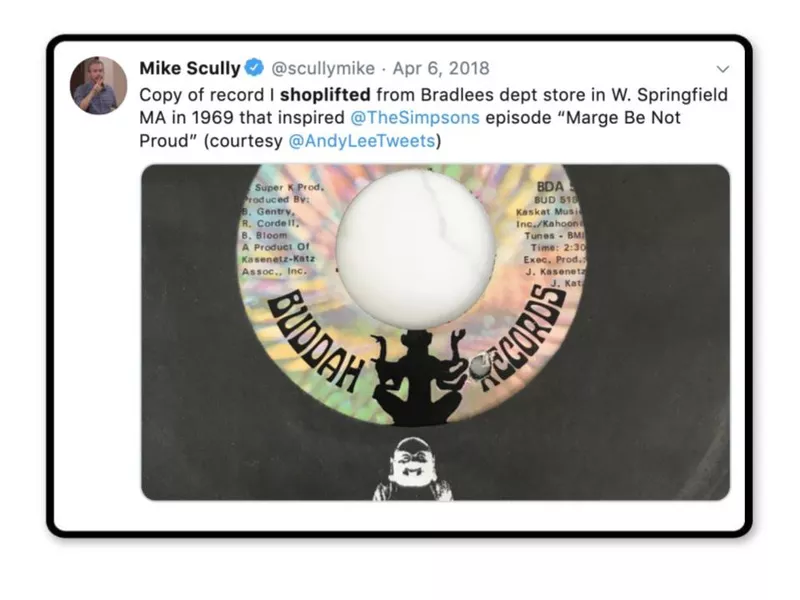
scullymike / Twitter
KB Toys
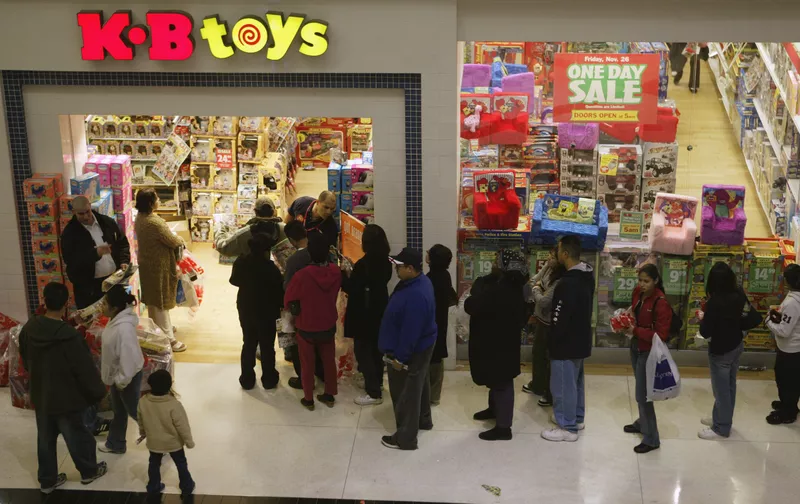
Early morning shoppers wait in a queue outside the KB Toys store in Glendale Galeria mall Friday Nov. 26, 2004, in Glendale, California. Damian Dovarganes / AP Photo
KB Toys started as a candy store in Pittsfield, Massachusetts, in 1922, but transformed into a shopping-mall based toy store by 1973. By 1998, KB owned 2,477 stores and had $1.6 billion in sales. But by 2000, the company was sold to venture capital firm Bain Capital LLC and had acquired over $300 million in debt. In 2004, it laid off over 3,400 employees and by 2009 was forced to close its remaining 600 stores. There was talk of KB-branded pop-up stores appearing during the holidays to fill the void after Toys R Us closed in 2018, but it never happened.
A Person on the Internet Says...
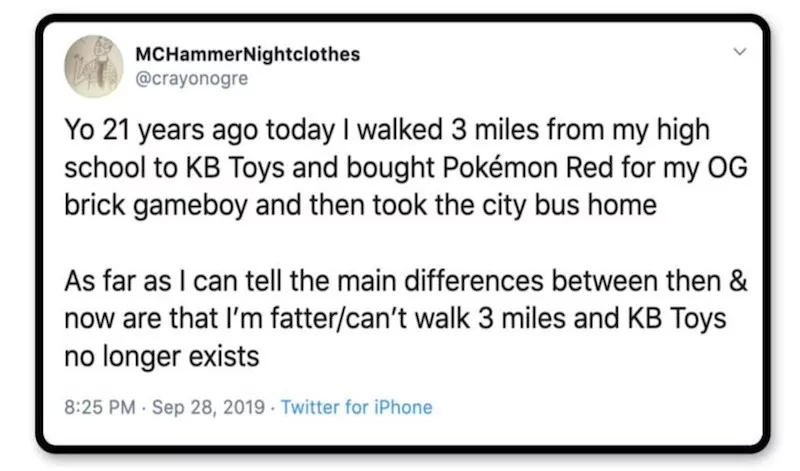
crayonogre / Twitter
Caldor
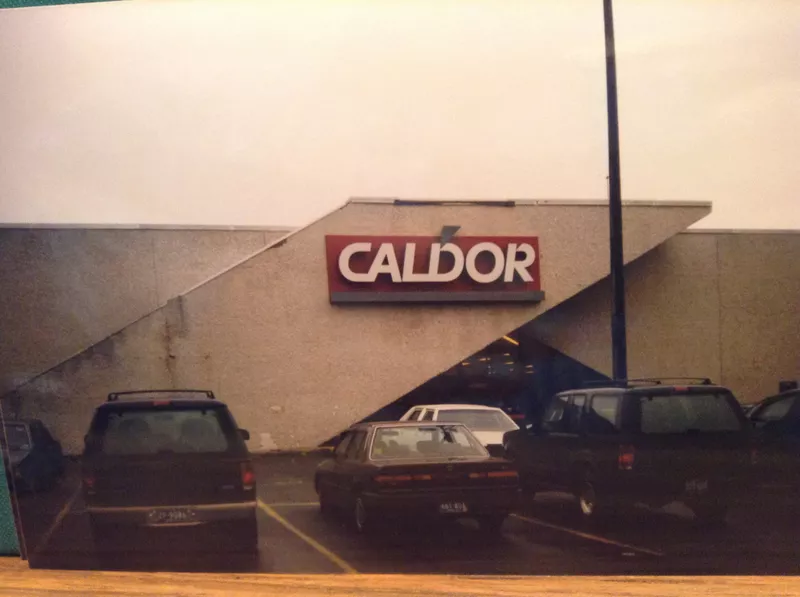
Mike Mozart / Flickr
Another discount department store that sold everything from clothes and toys to electronics and sports equipment, Caldor started as a small mom-and-pop operation in Port Chester, New York, in 1951. Things went well for about forty years until the 1990s, when it was the nation’s fourth-largest discount chain behind Walmart, Kmart, and Target. But those bigger retailers took a huge chunk out of its bottom line, and by 1995, the company had $883 million in liabilities compared to assets of $1.2 billion. The company declared bankruptcy, and by 1998, all of its “discount stores with a difference” were closed.
A Person on the Internet Says...

AllieLarkin / Twitter
Zany Brainy
Opened in 1991, Zany Brainy stores were packed with multimedia educational toys and products. Before its shuttering in 2001, Zany Brainy had 187 stores in 34 states, but faced stiff competition from Toys R Us, Target and Walmart, and its educational bent meant it wasn’t quick enough to stock hot toys like Pokémon or Beanie Babies. The company’s owners, David Schlessinger and Tom Vellios, went on to found FiveBelow, a discount store that sells children’s toys for below $5 and has around 900 locations.
A Person on the Internet Says...
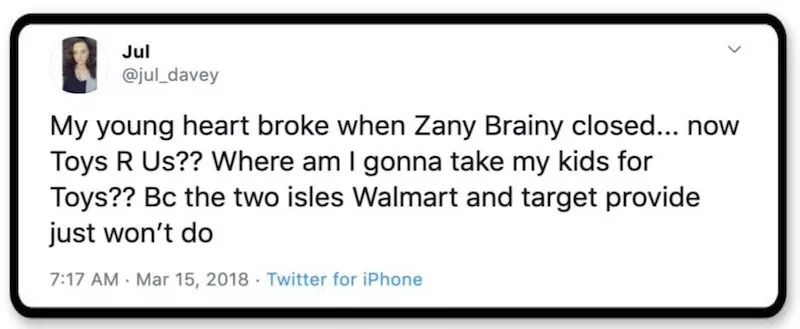
jul_davey / Twitter
The Warner Bros. Studio Store
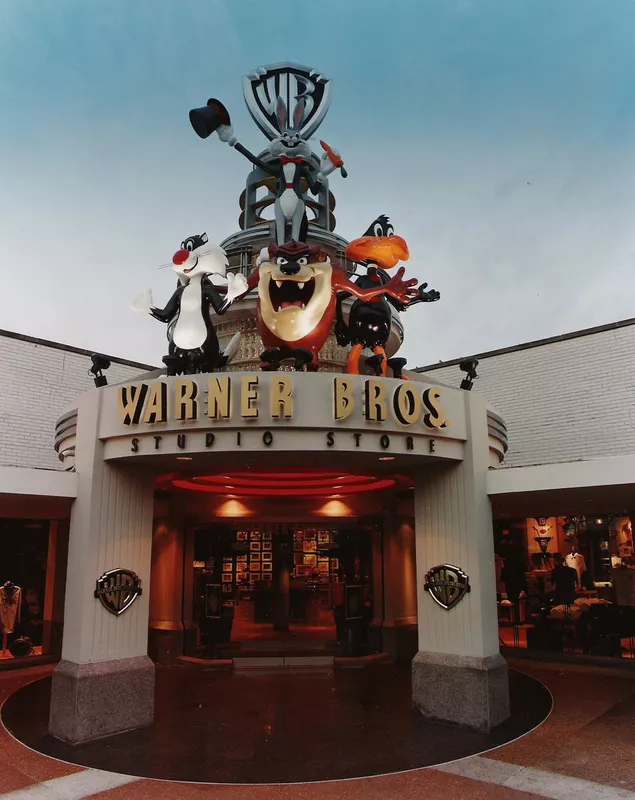
OrangeGrove55 / Twitter
The Warner Bros. Studio Store was a chain that sold a plethora of comics, movies and Looney Tunes-related items. These 130 glitzy stores typically had a full-sized Warner Bros.-character statue at the door (like Bugs Bunny) and props hanging from the rafters (like Gremlins). Pretty much any merch under the Warner Bros. umbrella could be found at these stores, from signed animation cell drawings to toys and clothes.
These stores were awesome for kids, but sales lagged. Shortly after the disastrous AOL-Time Warner deal of 2000, it was “That’s all, folks,” for the Warner stores the following year. They only remained in operation for 10 years. Oddly enough, Warner stores can still be found in China.
A Person on the Internet Says...
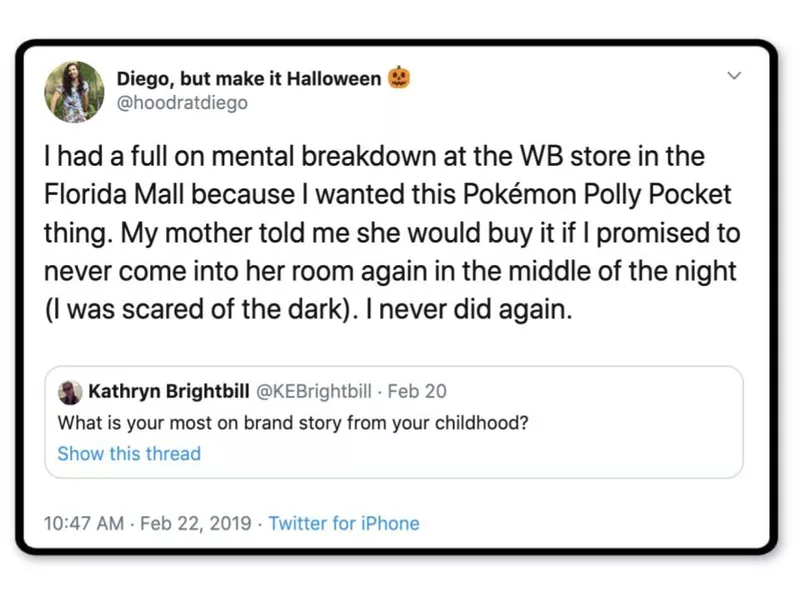
hoodratdiego / Twitter
Tweeter
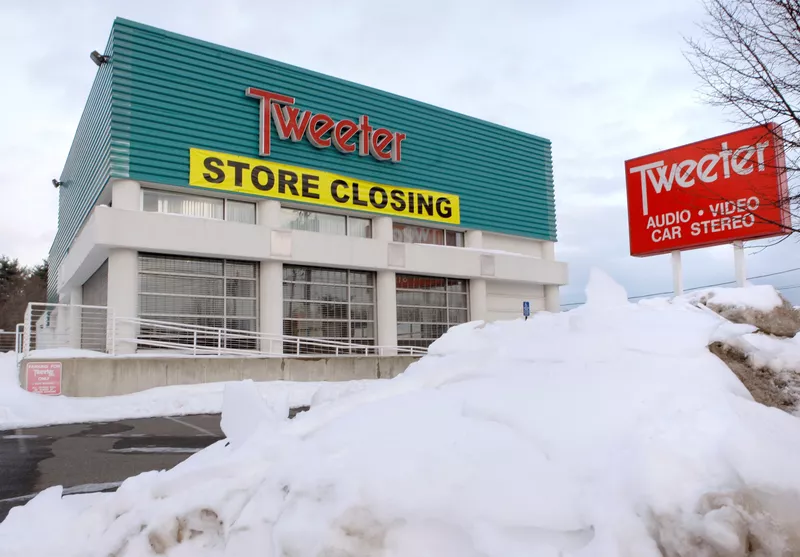
Charles Krupa / AP Photo
Tweeter was an electronics store company in New England and throughout the U.S. with 177 stores and almost $800 million in sales by 2002. In 2008, it flamed out spectacularly, abruptly closing its stores and firing all employees days before its final going-out-of-business sales days had concluded.
Employees hacked Tweeter’s website and accused the company’s owner of lying and breaking promises. Customers who had made purchases but had not yet picked up their items had to contact customer support to retrieve their items because Tweeter’s doors were closed for good.
A Person on the Internet Says...

hadgetunes / Twitter
Montgomery Ward

Beth A. Keiser / AP Photo
Montgomery Ward started as a mail-order dry-goods business in Chicago in 1872. Business was great — by 1908, a 1.25-million-square-foot catalog house and headquarters was built in downtown Chicago (it’s still a state landmark). By the 1920s, Montgomery Ward had expanded into retail outlets — and this is what gave us Rudolph the Red-Nosed Reindeer. In 1939, Montgomery Ward decided to create its own book as a Christmas giveaway and distributed over two million of them throughout the country.
But Montgomery Ward’s future was not so bright. Its decline started during the post-WWII years and continued for several decades until the company announced its lights would go out in 2000, closing 250 stores and laying off 37,315 employees. The announcement came three days after Christmas.
A Person on the Internet Says...

MamaMooMoo87 / Twitter
Sports Authority

MB298 / Wikipedia
Sports Authority had around 460 stores nationwide when it announced bankruptcy in 2016. Sales were siphoned by Dick’s Sporting Goods and it was facing a staggering debt bill of $1 billion due in 2017. The company announced it would lay off its 16,000 employees and close all its stores. Dick’s purchased the rights to the Sports Authority name and IP for just $15 million in 2016.
A Person on the Internet Says...
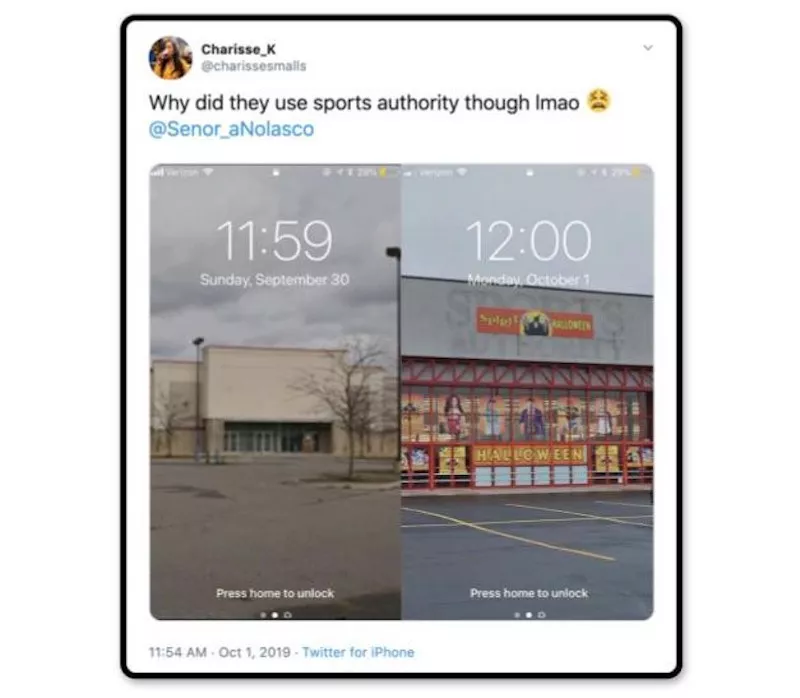
charissesmalls / Twitter
Zayre

Phillip Pessar / Flickr
You could “get it all” at this discount store for about 34 years, before it shuttered in 1990. Zayre was a company from Framingham, Massachusetts, which expanded to cities in 1978 and enjoyed a growth period for doing so. By the 1980s, it had 907 outlets and was the 18th largest non-food retailer in America.
A New York Times article from 1985 touted how Zayre had “bounced back” after harsh times, yet three years later Zayre would sell its discount department stores to Ames for $800 million. Zayre merged with its subsidiary, TJX Companies, which owns Marshalls, Homegoods and Sierra, which are still around. But Zayre? Not so much.
A Person on the Internet Says...
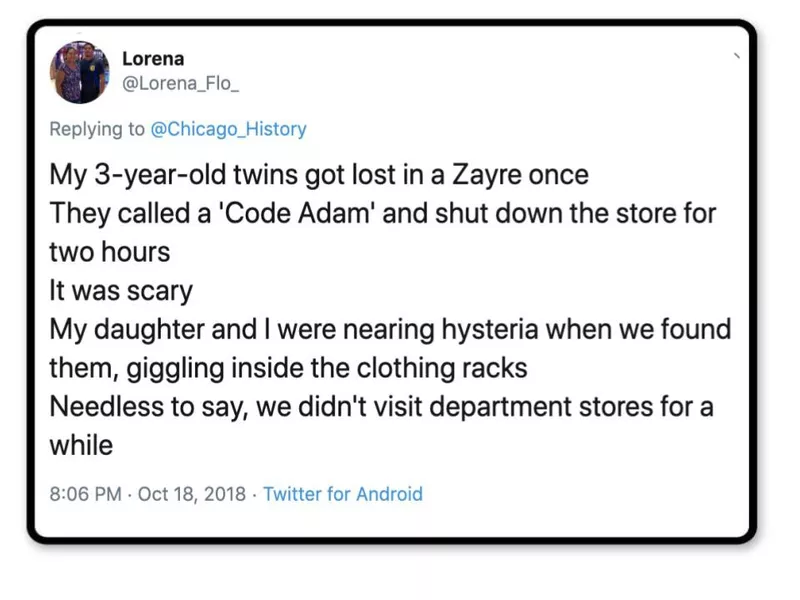
Lorena_flo / Twitter
Ames
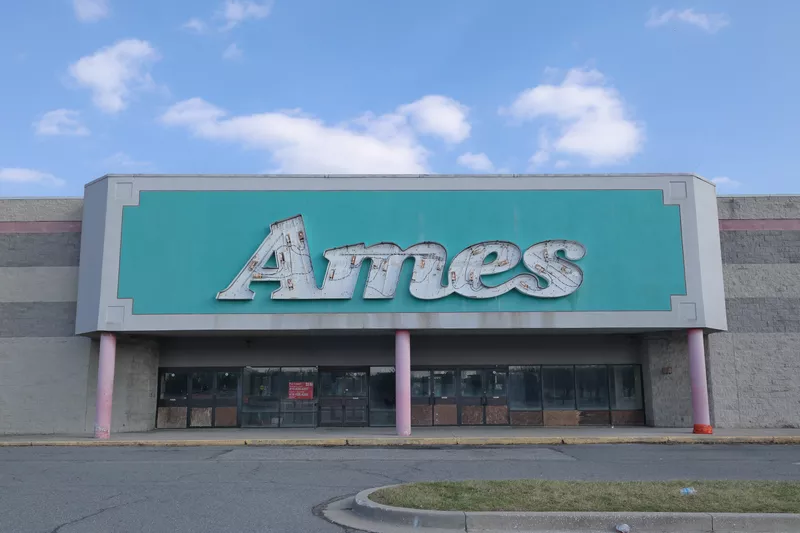
22408aaron / Wikipedia
Like many other discount department stores, Ames was a discount retail giant before succumbing to the harsh business environment of the 1990s. But Ames did itself no favors. In the 1980s, it went on its own spending spree, acquiring King’s Department Stores, G. Murphy and Zayre, adding hundreds of stores that would need to be converted into Ames outlets and more overhead to its bottom line. The Rocky Hill, Connecticut-based company filed for bankruptcy in 1992, expanded to Chicago in 1998 and crashed in 2002.
A Person on the Internet Says...
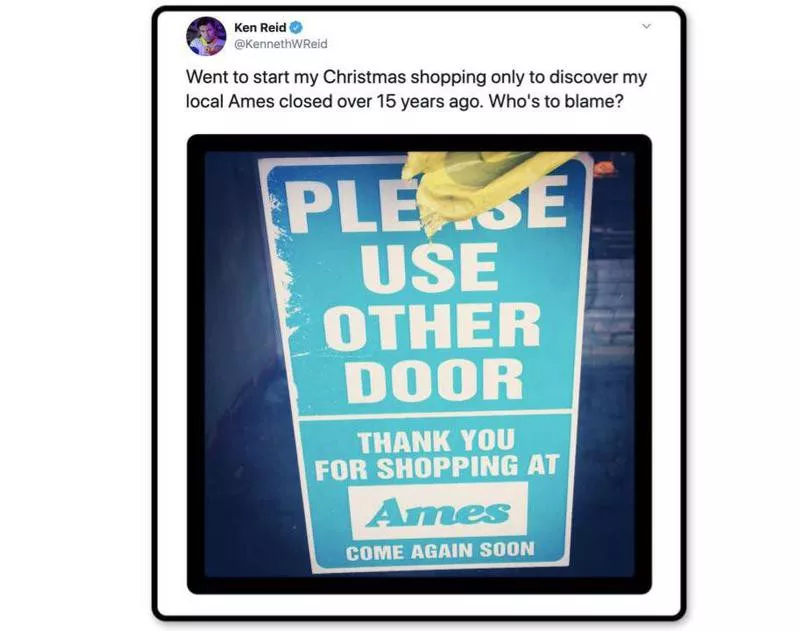
KennethWReid / Twitter
The Discovery Channel Store
The Discovery Channel Store was intended to be the store for children with a scientific imagination. They were quite cool. These mall retail outlets included smart toys, telescopes, DIY science kits and unusual knickknacks. But sales were mediocre and Discovery’s retail experiment was short-lived. The first Discovery store opened in 1995 and all 103 locations were closed by 2007, laying off around 1,000 employees.
A Person on the Internet Says...

heyoitsbekah / Twitter
Waldenbooks

David Wilson / Flickr
Waldenbooks started as a noble cause. The company’s origins began in 1933, during the height of the Great Depression, as a book-borrowing company that lent books for three cents a day. The founders “believed [it] would help people cope with the effects of the Depression,” according to Encyclopedia.com. These book leasing stores operated at least until 1969, and at the same time, Waldenbooks expanded into the bookselling space. Kmart acquired Waldenbooks in the 1980s along with Borders, which would lead to transforming most of its stores into Borders Express outlets. By 2010, the majority of those stores were closed, and in 2011, all of Waldenbooks, along with Borders Group, went under.
A Person on the Internet Says...

cubezombie / Twitter
The Nature Company
A place with a customized stone or wood archway, which led to a store filled with fossils, gemstones, kitschy toys, wind chimes and the sound of soothing rain music, The Nature Company started in 1972 out of Berkeley, California. By 1997, it was purchased for $40 million by Discovery for $40 million. The stores were converted into Discovery Channel Stores in the next few years.
A Person on the Internet Says...

Paladin1969 / Twitter
Media Play
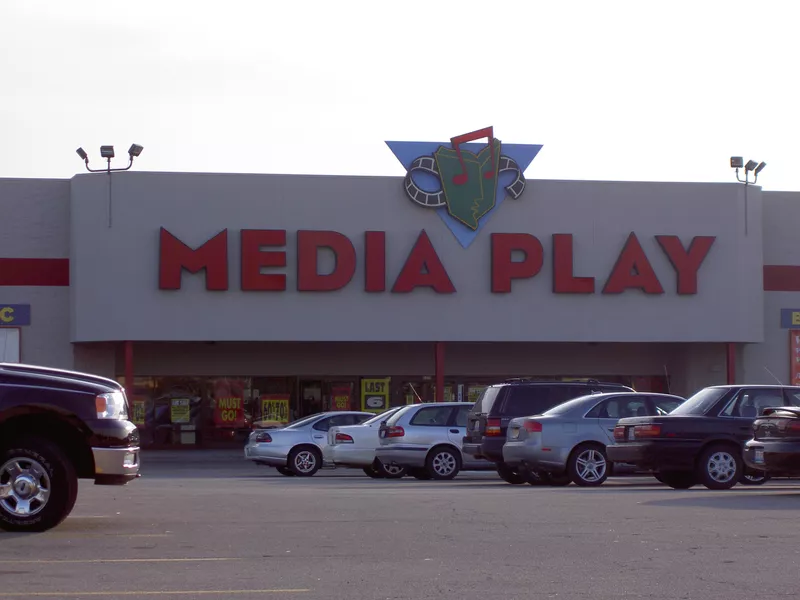
Adam Lautenbach / Wikipedia
Media Play was a chain that sold music, books, games, movies, computer software, toys, electronics and related merchandise. It opened in 1992 and went defunct 14 years later. But the trouble started earlier than that, with about two dozen stores closing in 1996. One store in Minneapolis had been open for only 45 days before shutting down.
Costs were an issue. According to Billboard, each store cost $1.5 million to build and another $3 million to stock. Musicland Group, Media Play’s parent company, filed for Chapter 11 in 2006 and closed all of its Media Play stores. At its height, around 95 stores were open nationwide.
A Person on the Internet Says...

kingharrison / Twitter
Jordan Marsh
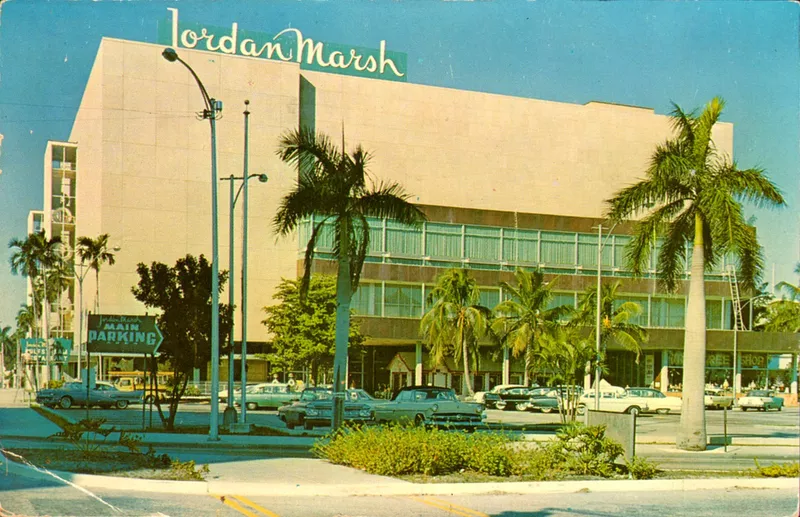
Ryan Khatam / Flickr
Jordan Marsh was a Boston-based department store that opened in 1851 and operated from a brownstone flagship corner store in downtown Beantown. The company expanded into the suburbs in the 1950s, became the largest chain in New England in the 1970s, and then established new locations in Miami and San Diego. But by 1990, the company had taken on heavy debt. It was acquired by Macy’s in 1996, with all remaining stores converted into the Macy’s brand.
A Person on the Internet Says...
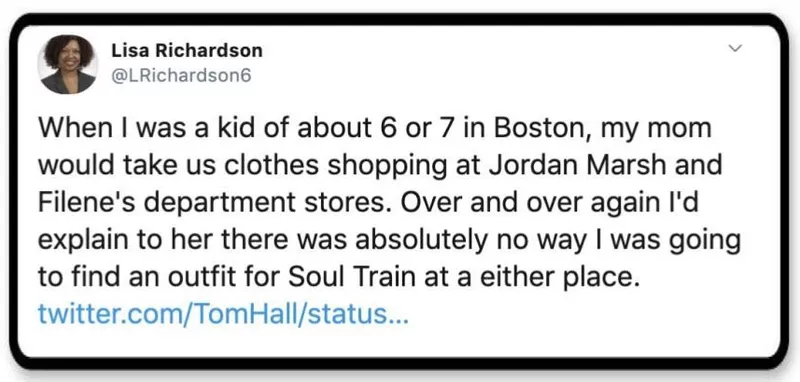
LRichardson6 / Twitter

